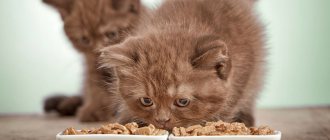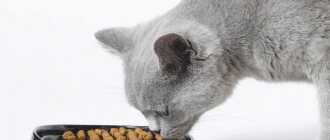Save the article:
The health and mood of the cat depends on how and what the owner feeds his beloved pet. Feeding a kitten at 2 months
it is necessary according to the recommendations of specialists: the baby is already feeding on his own, many are left without a mother, and the further development of the cat depends on the owner.
The diet of two-month-old kittens differs from the diet of a 1-month-old kitten. The body continues its development and growth, mother's milk and formula are no longer required. If you don’t choose the right balanced diet, your baby’s immunity will begin to weaken. Therefore, it is important to study all the nuances of feeding a two-month-old kitten and not make unnecessary and dangerous mistakes.
Choosing a diet for a two-month-old kitten
If the diet is chosen correctly, then soon the clumsy baby will turn into a playful, strong and powerful cat or a beautiful healthy cat. The main signal that the food is not suitable for the kitten is an intestinal disorder and the animal’s categorical refusal of the offered treat.
There are three options for suitable nutrition for young cats, and the choice should be made on one of them:
- ready-made feed:
- natural food;
- mixed nutrition.
Probably, the kitten himself will make the choice for the owner. But sometimes it’s worth calculating your financial capabilities and choosing the best option. The breed of the cat, its health and preferences also play a role.
Eye cleaning
A healthy kitten's eyes are always moist. But if dry crusts appear in the inner corners, pus is a sign of disease. In this case, eye care is necessary. The accumulations are removed with a napkin soaked in boric acid or in a solution of furatsilin (as prescribed by a veterinarian) in the direction from the outside to the nose.
With normal lacrimation, eye care does not require special products from the pharmacy. It is enough to rinse in the same direction (towards the nose) with regular tea leaves or chamomile decoction.
Advice: when carrying out the procedure, it is better not to use cotton swabs or pads, as individual fibers get into the eyes and cause discomfort, which will make further eye care problematic.
Ready-made feed
global $ads_google;
//data-ad-slot=”2475549904″ $ads_google = empty($ads_google) ? false : true; ?> if ($ads_google == false) {?> $ads_google = true; ?> } ?> Ready-made food can be dry or wet. For a two-month-old baby, it is contraindicated to mix them with each other, since they are digested at different time intervals, and the baby’s stomach is not yet ready for such a feat.
If, after feeding one type of food, you need to switch to another, then accustoming to the new food occurs gradually over 10 days: small portions are introduced and the body’s reaction is monitored.
Some manage to combine two types of cat food, 75% of the nutrition is the dry variety, the rest is wet.
A good food manufacturer offers products taking into account all cat characteristics. For this purpose, whole lines of food are produced: from 2 months to a year, from a month to four. The composition of such nutrition is selected with the optimal content of calcium, protein, vitamins and minerals.
Advantages and disadvantages
The main advantage of ready-made food is that it is already a balanced source of nutrition, where the vitamin and mineral complex is fully adapted to the nutrition of a two-month-old animal.
Another plus is the dry food itself: the baby actively works with his jaws in an attempt to chew the tasty granule. The owner does not need to select the composition of the food himself or calculate the required content of nutrients - in general, this is a great time saver.
It is convenient to take ready-made food on a trip without worrying about what the baby will eat if the journey is long.
Disadvantages of nutrition:
- Economy class food contains a large amount of unnecessary mineral salts. They accumulate in the body and provoke urolithiasis;
- The granules contain flavorings and preservatives that cause addiction. You can switch to natural food only by forcing your pet to starve.
It is better to ask your veterinarian whether it is worth giving your baby such food.
What veterinarians say
If it is difficult and unclear what to feed a kitten at 2 months
, seek advice from a veterinarian.
- Buy food only in veterinary pharmacies and pet stores.
- It is best if it is marked “premium” or “super premium”.
- Holistics are considered the best foods; their benefits are maximum, as they preserve the freshness of almost unprocessed meat.
- Purchase products indicating the appropriate age of the animal.
- Portions are given according to the dosage indicated on the pack.
If you follow the advice, you will not have any problems with nutrition.
Is plant milk suitable for a kitten?
Owners of kittens who support a vegetarian diet are wondering whether their kittens can be given plant-based milks.
Almond milk is made from a mixture of ground, unroasted almonds and water. There is no lactose in this milk. But almonds are toxic to cats.
Soy milk also does not contain lactose. But soy is very difficult for the delicate cat’s body to digest, since the kitten’s body does not have enzymes to process it. Even if your pet drinks soy milk, there will be no benefit from it.
Coconut milk is obtained by squeezing coconut pulp. Due to the high fat content of coconut milk, it is not only not healthy for the kitten, but in large quantities it is very harmful and leads to excess weight gain.
Cats are carnivores by nature, which makes it difficult for them to absorb plant-based substances. Therefore, you should not experiment with your pet’s nutrition. All a kitten needs is ordinary clean water. It is needed for the development of the cat’s body and promotes better absorption of food.
Kittens do not digest plant milk well
Natural food for kittens of two months
The owner of a growing cat sooner or later asks whether it is possible to feed the baby homemade food. The question has a twofold answer: yes and no.
Not if home-cooked food means food prepared for the whole family. And yes, if it is a separately prepared food, taking into account the age characteristics of the pet, its health and other characteristics. Such food will be devoid of harmful additives and unnecessary ingredients.
Advantages and disadvantages
global $ads_google;
//data-ad-slot=”2475549904″ $ads_google = empty($ads_google) ? false : true; ?> if ($ads_google == false) {?> $ads_google = true; ?> } ?> And natural food has its pros and cons.
Advantages:
- Since the owner himself selects the diet, it is no secret to him what the food will consist of. A caring owner can be calm about both the quality and composition of the food;
- food becomes varied;
- there is no food addiction, and products are interchangeable without any stress for the kitten.
Flaws:
- you need to remember which products are on the list of prohibited foods and do not offer them to your young cat;
- there is a possibility of not receiving the required amount of vitamins and minerals, so they will need to be purchased separately. Adding them to a dish is difficult when calculating the correct dosage.
If the owner decides on natural nutrition, then he must study all the accompanying recommendations.
Feeding recommendations
The second month of a kitten’s life is active, the baby needs a lot of energy and strength. The daily diet includes meat products: beef, turkey, chicken. Cooked meat is given in ready-ground form and added to the broth. Raw meat is still prohibited!
In order for the skeletal system and teeth to develop well, the kitten is fed kefir, fermented baked milk, yogurt without additives, and low-fat cottage cheese is introduced by the end of the second month.
The diet includes milk porridges made from cereals and cereals, or porridges with a decoction of vegetables or meat, vegetables and low-fat boiled sea fish without bones.
There are prohibited foods: pork, lard, pork fat, goose, bones, cow's milk, raw egg whites, pickles, chocolate. Freshwater fish and legumes should not be offered.
Expert opinion
The opinions of experts on the issue of milk consumption by kittens and adult cats are ambiguous. On the one hand, milk is a rich source of vitamins, proteins, microelements and fats. On the other hand, excessive amounts of milk in your pet's diet can be harmful to health.
An excellent alternative to milk as an additive to a cat's diet is fermented milk products. It is important that it is natural, without sugar and various additives. Giving your cat fermented milk products is safe because they do not contain lactose. Products should have a small percentage of fat, but not low-fat. It is important that all fermented milk products fed to the cat are fresh.
It is not allowed to feed cats hard and salty cheeses, sweet fermented milk products. Sour cream, cream, cottage cheese or natural yogurt - these products are healthier and much safer for the cat.
Mixed nutrition
There is an opinion that simultaneous feeding of natural food and ready-made food is harmful to kittens and can even give rise to the development of diseases of the digestive organs. The opposite opinion states that a two-month-old pet will get just everything it needs from a mixed diet. The dosage of nutrition is clarified by a veterinarian: he will take into account the animal’s health status, weight, breed and suggest a feeding plan.
The selected diet will remain this way throughout the month. The main difficulty will be to prevent hypervitaminosis. Therefore, you must strictly adhere to the calculated dosage.
How to feed a kitten at two months
There are simple rules for feeding a two-month-old pet:
- The daily portion of natural food is not given immediately, the baby does not yet control his appetite. Dry food can be poured in immediately;
- all food should be warm. If the food was in the refrigerator, it is heated;
- cooked food should not be stored in the refrigerator for longer than 24 hours;
- wet prepared food is stored open for no more than two days;
- if the food is natural, vitamins for cats are added to it;
- There is water in a separate bowl. The bowl should be freely accessible, and the water should always be clean and fresh.
It will not be difficult for a responsible person to follow all the nutritional rules for a kitten, and the pet will grow up strong and healthy.
How often to feed a 2 month old kitten
global $ads_google;
//data-ad-slot=”2475549904″ $ads_google = empty($ads_google) ? false : true; ?> if ($ads_google == false) {?> $ads_google = true; ?> } ?> To avoid problems with the baby’s health, you need to know how many times to feed and what the portions should be.
The kitten should not overeat or remain hungry - both cases promise problems with the digestive system.
A baby at 8-10 weeks is fed frequently: the daily diet is calculated at 5-6 small portions. If we take into account the weight of the kitten, then we proceed from an approximate recommendation of 150 g per 1 kg of body weight.
Claws
In principle, you can do nothing at all with claws, if you don’t feel sorry for the furniture upholstery. Otherwise, you will have to wean your pet from the habit of tearing up everything. You can do this in several ways:
- buy a scratching post, spray it with catnip that is attractive to these pets, and teach how to use it by smoothly running your paws with extended claws over the surface of the device (often scratching posts are already sold impregnated with special compounds to attract the attention of cats);
- put caps on the claws and monitor the kitten’s reaction (whether it will be comfortable for him to wear them);
- trim the claws, cutting the length no more than 1 mm from the edge, so as not to cause pain to the kitten.
These measures will be enough to try to protect furniture upholstery and wallpaper from tearing.
Features of feeding kittens at 2 months in different breeds
The diet depends on the breed: some cats need more protein, while smaller animals cannot cope with large portions. Different cats have different nutritional recommendations. If a kitten is adopted from a breeder, then you can get full advice on many issues on the spot, including diet. If a kitten is just taken from the breeder, then be sure to first continue to feed it the same food to which it is accustomed. A change in diet, if desired, occurs only after 2 weeks.
Feeding Scottish kittens
At 2 months, the little Scotsman is weaned from the cat's breast. The fold-eared baby is weaned gradually, without causing stress to either the kitten or its digestive system. The Scottish cat's diet consists of 6 servings with a total volume of 160-180 g per day. It is better to mix meat with vegetables and cereals in a 3:1 ratio. At one meal they give a meat and vegetable dish, at another - meat porridge.
Feeding a Maine Coon kitten
A Maine Coon kitten at 2 months can be fed natural food: offal, yolk, fermented milk products, and cereals are used. Vegetables are given up to 16 times a month. It is useful to feed the future cat with sprouted grass and shrimp. Maine Coons should not be offered salty foods, especially those with spices and pork.
The total amount of food per day is 210-240 g.
Feeding a Sphynx kitten
At 2 months, there are also some recommendations for a hairless Sphynx kitten. They benefit from rice broth, buckwheat and oatmeal. Boiled carrots, beets and cabbage are also added. They don't give milk to bald people! Instead, they offer kefir and 0-5% cottage cheese.
All products must be fresh, and dry food must not be expired by a day. Saltiness and smoked foods are contraindicated for the Sphinx.
Feeding a Bengal kitten
At 2 months, a Bengal kitten has its own food requirements: this breed loves meat very much. Boiled meat is cut into tiny pieces, and raw frozen meat is simply scraped with a knife, cutting off the top layer. Then the shavings are warmed to room temperature and offered to the pussy. But it’s better to stick to boiled meat. Bengal will appreciate porridge made with meat broth and the consistency of sour cream. Raw vegetables are not offered.
The baby is fed 6 times a day.
Feeding a British kitten
A young Briton eats 7 times a day at 2 months old. You can treat your baby to milk for kittens (25% of the diet), low-fat cream and cottage cheese (not at the same time as milk), milk porridge and canned food for kittens.
The British breed will also not refuse boiled meat, cut into small pieces.
the washing up
There is no need to wash your pet often; once every 1 or 2 months is enough. In order for the kitten to get used to water faster, it is important to provide him with comfortable washing:
- lay a rag on the bottom so that the paws do not move apart;
- make the water temperature about 38 C;
- depth - to the middle of the paws;
- the stream should be thin;
- be sure to stroke and talk to your pet affectionately (since the first bath can frighten the baby);
- Use a special shampoo for cats and rinse it off thoroughly.
The basic rule is that when washing, do not wet the kitten’s head, ears and eyes . After the procedure, wrap the animal in a soft towel and dry the fur, and then do not let the dry pet into drafts.
© shutterstock
Caring for kittens at 2 months
Touching meowing babies at two months of age remain fragile creatures. They are ready to be attacked by infections and parasites. The owner’s task is to protect the fluffies from danger. Timely vaccinations and timely deworming will help fight infections.
The veterinarian should be a friend: a source of necessary advice and regular examination.
The baby's appearance needs care: this is the time to accustom him to a comb, the procedure of washing his eyes and cleaning his ears. A healthy pet sparkles with beautiful fur and is in a good playful mood.











